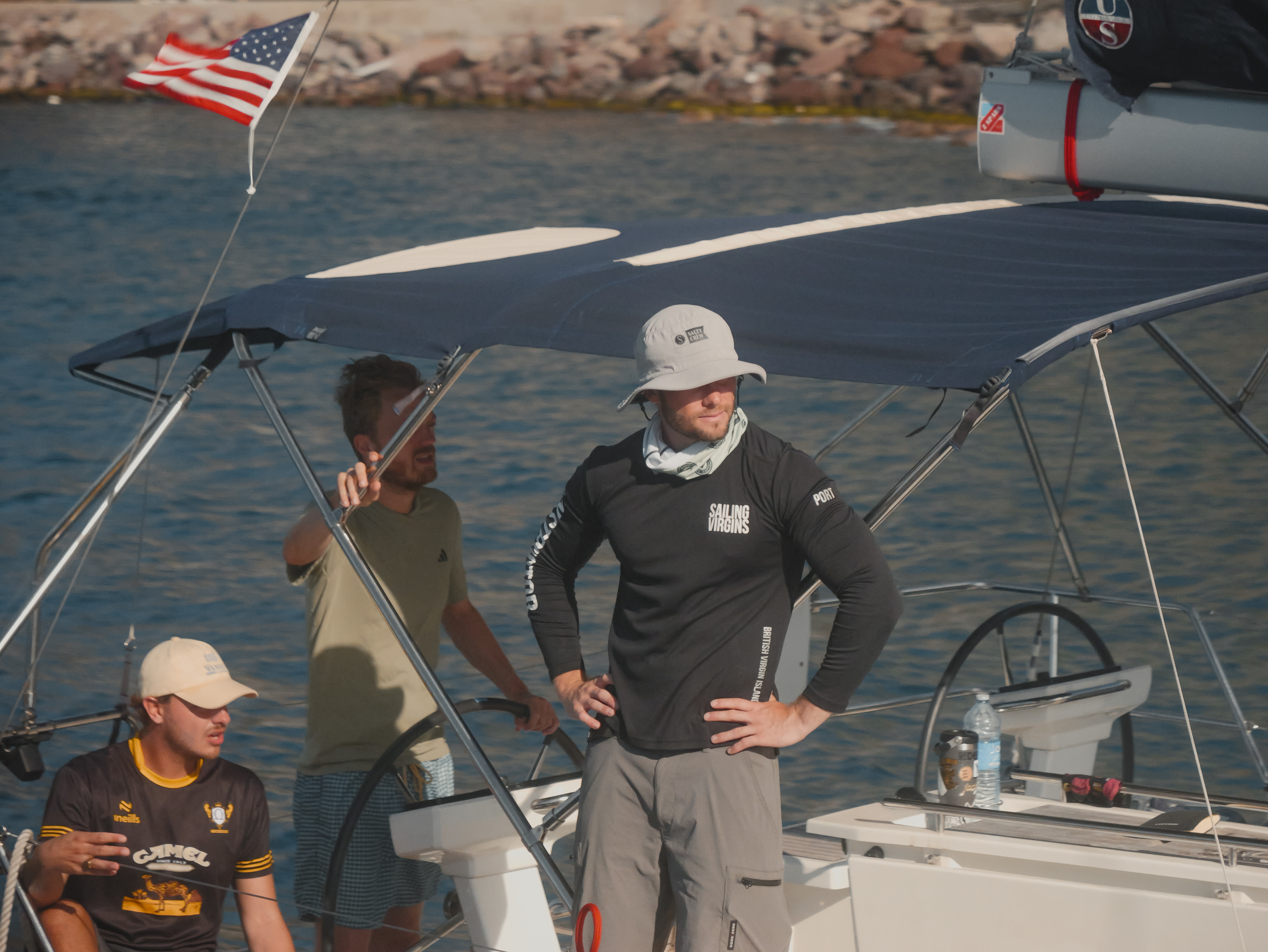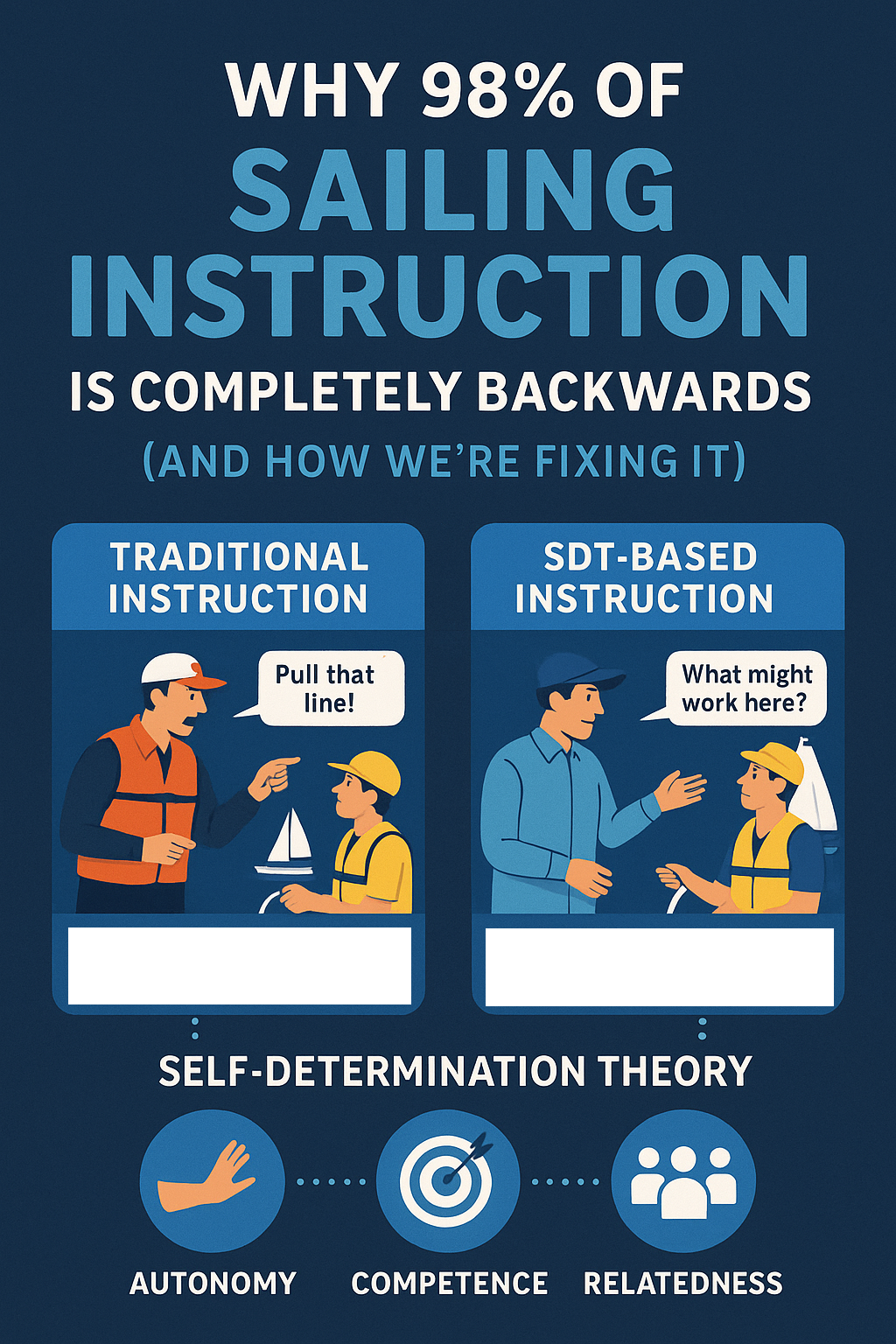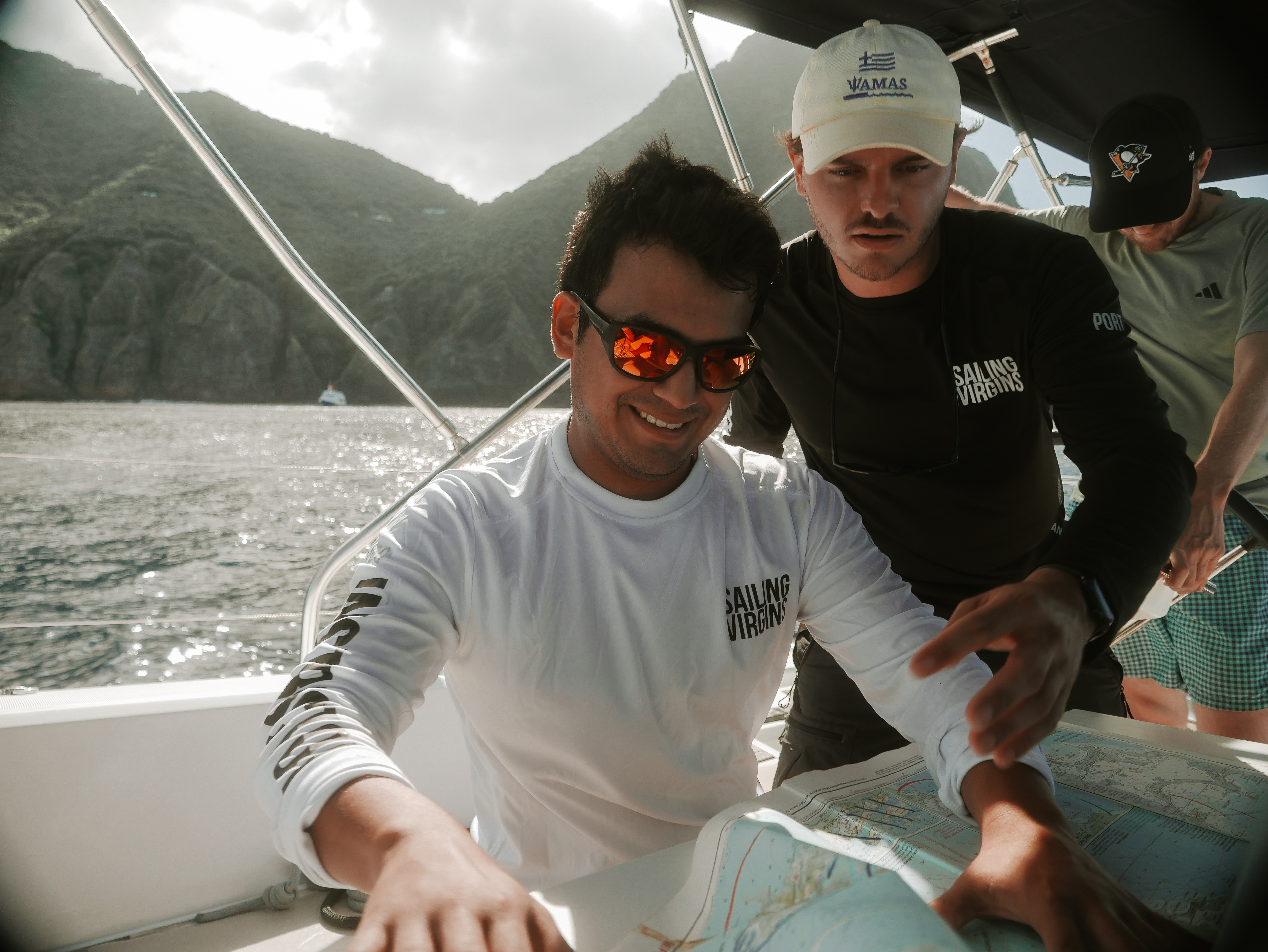Posted on October 11, 2025 by Chris Sebastian
Why 98% of Sailing Instruction Is Completely Backwards (And How We're Fixing It)
By James Kell, Founder of Sailing Virgins
Let me ask you something: When was the last time you learned something meaningful because someone barked orders at you?
I'll wait.
Can't remember? That's because humans don't work that way. Yet walk onto almost any sailing school dock, and you'll hear: "Pull that line! Not that one! No, clockwise! Three wraps, not four! Because I said so!"
It's military-style instruction for people who signed up for an adventure. It's teaching adults like they're recruits. And it's completely, utterly backwards.

The Problem Nobody Talks About
Here's what the sailing industry doesn't want to admit: We're losing people. Not because sailing is too hard, too expensive, or too complicated. We're losing them because traditional instruction makes them feel incompetent, controlled, and disconnected.
Think about it. Our typical student is a successful millennial. They run companies, manage teams, make complex decisions daily. Then they step onto a boat and suddenly they're being treated like they can't think for themselves.
"Stand there." "Hold this." "Don't touch that." "Do exactly as I say."
No wonder so many people take one sailing course and never come back.
Enter Self-Determination Theory (The Science That Changes Everything)
About two years ago, I stumbled across something called Self-Determination Theory (SDT). Developed by psychologists Edward Deci and Richard Ryan, it's arguably the most validated theory of human motivation in existence.
The premise is simple: Humans thrive when three basic psychological needs are met:
- Autonomy - The need to feel volitional and self-directed
- Competence - The need to feel effective and capable
- Relatedness - The need to feel connected and belonging
When these needs are satisfied, people don't just learn better. They fall in love with what they're learning.
When these needs are crushed? They comply, they endure, they leave.
Guess which approach most sailing schools use?
What This Actually Looks Like on the Water
Let me show you the difference between traditional instruction and SDT-based teaching with a real example from last week.
Scenario: Student Can't Get the Boat to Point High Enough
Traditional Instructor: "You're pinching. Fall off 10 degrees. More. No, that's too much. Come back up 5. There. Hold that. Keep your eyes on the telltales."
Student learns: Do what you're told. The instructor has the answers. You don't.
SDT-Trained Instructor: "What's the boat telling you right now? How does she feel? Interesting - you mentioned she feels sluggish. What might happen if we eased off the wind slightly? Want to experiment?"
Student learns: I can read the boat. I can solve problems. I'm becoming a sailor.
See the difference? Same skill taught. Completely different experience.

The 98/2 Rule We Live By
At Sailing Virgins, we've developed what we call the 98/2 Rule:
98% of instruction should be SDT-based - fostering autonomy, competence, and relatedness.
2% directive instruction - reserved for immediate safety, emergency situations, or when students explicitly ask for direct instruction.
This isn't about abandoning expertise or structure. It's about deploying expertise differently. Instead of telling students what to do, we help them discover what works. Instead of creating followers, we create decision-makers.
Why This Matters for Sailing (And Why Physics Is on Our Side)
Here's what's brilliant about sailing: The sport naturally supports SDT principles better than almost any other activity.
Autonomy: The wind and water don't lie. Make a decision, see immediate results. No instructor interpretation needed. The boat either moves faster or it doesn't. You either make the mark or you don't. Reality is your teacher.
Competence: Sailing provides perfect progressive challenges. Start in light winds, simple manoeuvres. Build to stronger conditions, complex navigation. Every session offers that sweet spot - challenging enough to engage, achievable enough to build confidence.
Relatedness: You literally can't sail a bigger boat alone. Success requires teamwork, communication, trust. The sailing community is one of the strongest on the planet because we depend on each other.
The Language Revolution
Want to transform your teaching (or recognise great instruction when you see it)? Here's the language shift:
Instead of: "Do it this way"
Try: "What might work here?"
Instead of: "You're doing it wrong"
Try: "Interesting approach - tell me your thinking"
Instead of: "Watch me"
Try: "Who wants to experiment with this?"
Instead of: "Because I said so"
Try: "Here's why this matters..."
Real Results from Real Students
Since implementing SDT at Sailing Virgins:
- Our students don't just pass certifications - they actually sail afterwards
- We've seen a 40% increase in students returning for advanced courses
- Our referral rate has doubled (people recommend transformational experiences, not just "courses")
- Instructors report higher job satisfaction and less burnout
But here's my favourite metric: The number of students who say "I surprised myself" has gone through the roof.
That's what happens when you treat people as capable humans rather than empty vessels to fill with instructions.
For Aspiring Instructors: This Is Your Opportunity
If you're thinking about becoming a sailing instructor, you're entering the industry at an incredible moment. The old guard is retiring. The military-style teaching is dying out. Students are demanding better.
At Sailing Virgins, every instructor is trained in SDT principles. Not as an add-on, but as the foundation of everything we do. We're not creating instructors who can recite the parts of a boat. We're developing coaches who can transform lives.
The best part? SDT makes instructing more fun. Instead of repeating the same commands all day, you're facilitating discoveries. Instead of fixing mistakes, you're building confidence. Instead of creating dependency, you're developing autonomy.
For Potential Students: This Is What You Should Expect
If you're considering learning to sail, here's what modern, SDT-based instruction feels like:
- You'll make meaningful choices about your learning journey
- Your questions won't just be welcomed - they'll drive the curriculum
- You'll learn by doing, not by listening
- Mistakes become learning opportunities, not failures
- You'll feel part of a crew, not just a class
- You'll leave feeling capable, not just certified
More importantly, you'll actually want to keep sailing. Because when learning respects your autonomy, builds your competence, and connects you to others, it stops feeling like education and starts feeling like adventure.
The Revolution Is Here
Look, I know this sounds like a lot of theory. But here's the thing: It works. Not because it's trendy or soft or politically correct. It works because it's based on how humans actually learn and what actually motivates us.
The sailing industry is changing. The question isn't whether instruction will modernise - it's whether schools will lead that change or be left behind.
At Sailing Virgins, we've made our choice. We're not interested in creating students who can follow instructions. We're creating sailors who can handle whatever the ocean throws at them. We're not building compliance. We're building confidence.

Your Next Step
For Instructors: Ready to revolutionise how you teach? Our next instructor training incorporates comprehensive SDT training. You'll learn not just what to teach, but how to create transformational learning experiences. [email us to apply for our instructor programme]
For Students: Want to experience the difference? Our courses run year-round in the British Virgin Islands, Croatia, and French Polynesia. Every single one uses SDT principles to ensure you don't just learn to sail - you become a sailor. [Check our upcoming courses here]
For the Curious: Download our free guide "10 Questions to Ask Any Sailing School" to identify whether they're using modern teaching methods or stuck in the past. [Get the guide here]
The Bottom Line
Sailing is freedom. It's adventure. It's challenge and beauty and connection. The way we teach it should reflect that.
When students leave Sailing Virgins, they don't say "I completed a course." They say "I became a sailor." They say "I surprised myself." They say "I can't wait to get back on the water."
That's the difference SDT makes. That's the revolution we're leading.
Welcome aboard.
James Kell is the founder of Sailing Virgins, where we're proving that the best way to create great sailors is to stop telling them what to do and start helping them discover what they're capable of.
Want to dive deeper into SDT and sailing? Follow us on Instagram [@sailingvirgins] where we share daily examples of these principles in action.